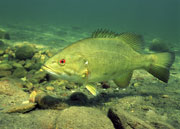|
Male fish producing eggs in Potomac River
William Cocke
for National Geographic News
1st November 2004
Smallmouth bass, like the one shown above, are one of many fish species whose males are demonstrating distinctly feminine behaviour. Male smallmouth bass appear to be producing eggs in the Potomac River, near Washington, D.C. The condition may be caused by chemicals that increase the level of hormones in the water.
Photograph courtesy U.S. Fish and Wildlife Service
Something fishy is happening in the headwaters of the Potomac River. Scientists have discovered that some male bass are producing eggs—a decidedly female reproductive function.
In June 2002 reports appeared of fish die-offs in the South Branch of the Potomac River. The West Virginia Division of Natural Resources asked U.S. Geological Survey (USGS) scientists to examine fish health in the watershed near the town of Moorefield, about three hours' drive from Washington, D.C.
Anglers were also reporting fish with lesions. USGS scientists determined that some of the lesions indicated exposure to bacteria and other contaminants.
The following year, the USGS conducted a more intensive assessment with a statistically significant number of fish, this time looking for internal damage. That's when they discovered a so-called intersex condition—where one sex exhibits both testicular and ovarian tissue.
"It was not something we were really looking for," said Vicki Blazer, a fish pathologist with the USGS's Leetown Science Center in Kearneysville, West Virginia.
Some 42 percent of male smallmouth bass surveyed showed signs of intersex development. A second sampling this spring produced an even higher rate percent showed sexual abnormalities.
Mysterious Sex Changes
The findings have perplexed the government scientists, who suspect a little-understood class of emerging contaminants. The contaminants include natural hormones excreted by humans and livestock as well as hormone-mimicking synthetic chemicals. The chemicals appear to confuse the endocrine systems of fish, essentially fooling males into producing female cells.
Endocrine disruptors work like biological disinformation campaigns. Sometimes mimicking natural hormones like oestrogen, they alter other hormone concentrations. The disruptors can either prevent or weaken the normal cell-signaling process.
David O. Norris, a professor in the University of Colorado's Department of Integrative Physiology, has specialized in environmental endocrinology for over 35 years. He is leading an ongoing research project looking into hormone pollution in three rivers in the Denver area.
"We're looking at the fish above and below where sewage treatment plant effluents are being added into the rivers," he said. "The best data we have are on Boulder Creek in terms of numbers of individuals. In all three cases we found reproductive abnormalities in fish downstream from where the effluent is."
Norris is focusing on white suckers, a species of fish not known for exhibiting intersex characteristics under normal conditions.
"Our impression is that they are males that are being feminized [because] of the nature of the chemicals that are in the water, and most of them are estrogenic [meaning they stimulate development of female sex characteristics]," he said. "Some of [the estrogenic chemicals] are natural urinary estrogenic products from humans, and some of them are pharmaceuticals—birth control pills."
Norris has also found large concentrations of compounds called alkylphenols—common substances often associated with household detergents and personal-care products.
"They're the same sort of compounds that have been associated with fishes in England and Europe," he said. "The main difference here is the source is domestic sewage, as opposed to industrial sewage. This is one of the first observations, certainly in the U.S., of a domestic sewage factor alone being connected with this [intersex phenomenon]."
Indicator Species and Water Quality
As for the South Branch of the Potomac River, Norris, like the USGS team, is unsure of the source of the pollution. "It's hard to say what the specific source might be [in the South Branch]. But I think the effect is very clear, that they're getting feminization," he said.
Currently USGS scientist Blazer said, the focus has shifted to analyzing water-quality data. "The water resources division of USGS out of Charleston put what are called passive samplers at a number of the sites," she said. "Basically they accumulate contaminants what fish tissue would accumulate over time. They expect to have the analyses of those back in November. We're hoping with that and some of the other water-quality things we're doing, we'll at least begin to get an idea of what we should be looking at."
Blazer added that her team would soon be conducting its fall collection, adding largemouth bass to the mix to test against a nationwide USGS largemouth-monitoring database. "Are we seeing the same thing in largemouth bass, or is there something about smallmouth, whether it's their food habits or when they spawn, that makes them more susceptible to exposure," she said.
Blazer said fish are good indicators of subtle changes in water quality—changes perhaps caused by the introduction of natural and synthetic hormones. Still, the exact cause of the sex-changed South Branch smallmouths remains unclear.
"Hopefully, when we get our data back, we can all sit down and really look at it and come up with some thoughts," she said.
Top
|
